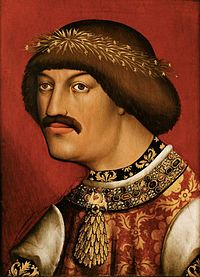Albert II of Germany
| Albert the Magnanimous | |
|---|---|
 |
|
| King of Hungary and Croatia | |
| Reign | 18 December 1437 – 27 October 1439 |
| Coronation | 1 January 1438, Székesfehérvár |
| Predecessor | Sigismund |
| Successor | Vladislaus I |
| King of Bohemia | |
| Reign | 6 May 1438 – 27 October 1439 |
| Coronation | 29 June 1438, Prague |
| Predecessor | Sigismund |
| Successor | Ladislaus the Posthumous |
| King-elect of Germany | |
| Reign | 18 March 1438 – 27 October 1439 |
| Predecessor | Sigismund |
| Successor | Frederick III |
| Duke of Austria | |
| Reign | 14 September 1404 – 27 October 1439 |
| Predecessor | Albert IV |
| Successor | Ladislaus the Posthumous |
| Born |
10 August 1397 Vienna, Austria |
| Died | 27 October 1439 (aged 42) Neszmély, Hungary |
| Burial | Székesfehérvár |
| Spouse | Elizabeth of Luxembourg |
| Issue |
Ladislas the Posthumous Anne, Duchess of Luxembourg Elisabeth, Queen of Poland |
| House | Habsburg |
| Father | Albert IV, Duke of Austria |
| Mother | Joanna Sophia of Bavaria |
Albert the Magnanimous KG (10 August 1397 – 27 October 1439) was King of Hungary and Croatia from 1437 until his death. He was also King of Bohemia, elected (but never crowned) King of Germany as Albert II, duke of Luxembourg and, as Albert V, archduke of Austria from 1404.
Albert was born in Vienna as the son of Albert IV, Duke of Austria, and Joanna Sophia of Bavaria.
He succeeded to the Duchy of Austria at the age of seven on his father's death in 1404. His uncle Duke William of Inner Austria, then head of the rivaling Leopoldinian line, served as regent for his nephew, followed by his brothers Leopold IV and Ernest the Iron in 1406. The quarrels between the brothers and their continued attempts to gain control over the Albertinian territories led to civil war-like conditions. Nevertheless, Albert, having received a good education, undertook the government of Austria proper on the occasion of Leopold's death in 1411 and succeeded, with the aid of his advisers, in ridding the duchy of the evils which had arisen during his minority.
In 1422 Albert married Elisabeth of Luxemburg, the daughter and heiress of the King Sigismund of Hungary (later also Holy Roman Emperor and Bohemia), and his second wife, the Slovenian noblewoman Barbara of Celje. Though Elizabeth was not the daughter of Sigismund's first wife Mary of Hungary and thus not a member of the royal Angevin dynasty, she descended from the old Árpád kings of Hungary. Her paternal grandparents were Emperor Charles IV and Elizabeth of Pomerania. Her maternal grandfather was the Ban of Slavonia Count Herman II of Celje, whose parents were Count Herman I of Celje and Catherine of Bosnia, who apparently descended also from Nemanjić kings of Serbia and from Catherine of Hungary, a daughter of Stephen V of Hungary. In right of the paternal grandparents, she was, through Elizabeth of Pomerania, also heiress of Poland, of its Kujavian Piast branch of kings. Thus, beside Hungary, Albert's marriage brought him claims to several Slavic kingdoms and principalities as well.
...
Wikipedia
